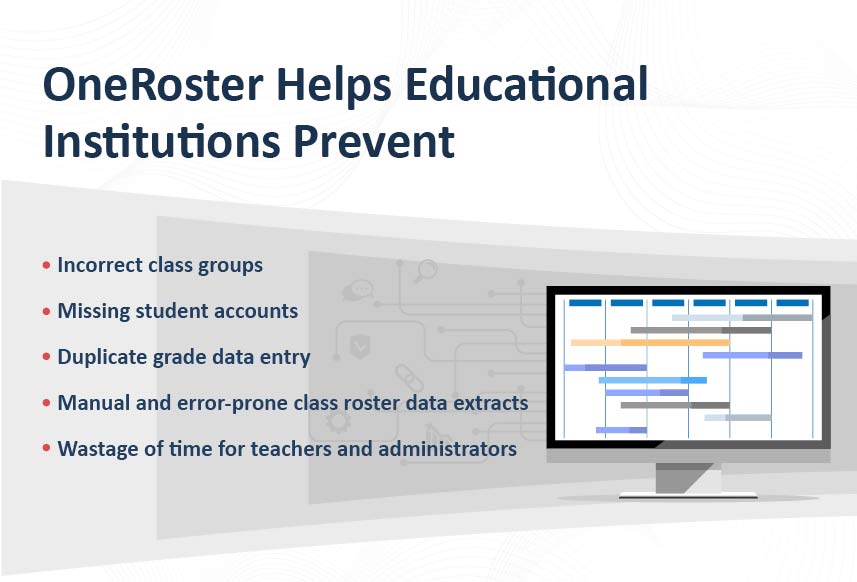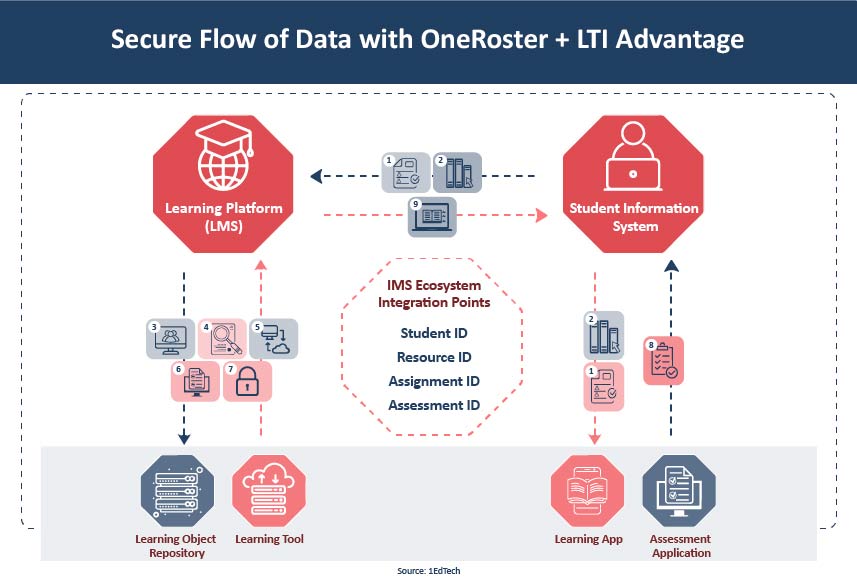
Learning tool interoperability, i.e., LTI and OneRoster integration is a hot topic in the EdTech industry. It’s a great way to enhance educational applications. Meeting 1EdTech Consortium (formerly known as IMS Global Learning Consortium) standards like LTI helps integrate rich educational applications with LMS and other platforms.
There are other 1EdTech Consortium standards that enable seamless transitions between learning tools and courseware within an LMS, providing a consistent and superior user experience. It’s possible to access external resources without additional login credentials and ensure your educational application adheres to LTI standards. If you’re looking to deliver a better learning experience in academia and Higher Ed, you should consider implementing LTI and LTI integration.
What is LTI?
LTI is a standard created by 1EdTech Consortium that connects different learning systems in a universal way. With LTI integration, learners can seamlessly move from one tool to another to experience different types of learning resources within an LTI LMS. This is made possible by an LTI application that provides a URL, key, and secret to be uploaded into the LMS by the administrator. LTI supports single-sign-on and user authentication via OAuth.
“What’s great about LTI integration is that it allows for a consistent user experience within the LTI application’s platform. It offers content creators an opportunity to craft unique learning experiences that can be easily shared. This feature makes LTI integration highly popular in academia and Higher Ed.”
LTI also enables seamless integration of third-party tools such as psychometric assessment tools within an LMS. The importance of LTI is exemplified in the scenario of integrating a psychometric assessment tool into an organization’s LMS. Without LTI, the tool would have to be redeveloped to conform to the SCORM standard and hosted within the LMS.
However, LTI provides a plug-and-play solution that enables seamless integration of external tools into the LMS, without the need to host the actual content. This enhances the user experience and provides content creators with the ability to easily share and integrate unique learning experiences across platforms.
To sum it up, say goodbye to the hassle of logging into different tools – LTI makes it a breeze to access one tool from another.
Thanks to LTI, your LMS can act as the ultimate access point for all your content and external resources. No more juggling multiple login credentials for different websites. Just pure, uninterrupted learning and teaching goodness, a key unlocking a seamless, consistent learning experience.
LTI 1.3 and LTI Advantage
LTI comes with a set of advantages that comprises a range of enhancements to the new core LTI 1.3 specification. This broadens its capabilities and facilitates more seamless integration between LMS and LTI tools. Together with LTI Advantage, LTI 1.3 is transforming digital education.
LTI Advantage is a package of three essential end-user services. These services, which build on LTI 1.3, enable the enhancement of the integration of any tool with any LMS by adding new features. The three primary feature services of LTI Advantage are:
- Assignment and Grade Services
- Deep Linking
- Names and Role Provisioning Services
What is OneRoster?
Advancements in technology have led to the proliferation of digital solutions in educational institutions. However, the use of tools from different vendors necessitates varying data inputs concerning class rosters, grades, and other student data.
For example, an LMS may require information regarding schedules, while certain learning tools may need data on student demographics. Consequently, processing large datasets becomes progressively difficult and wasteful for school districts and teachers.
To address this issue, 1EdTech developed the OneRoster standard which enables secure sharing of class rosters and associated data between student information systems (SIS) and LMS or any other system. This ensures compatibility between OneRoster-compliant tools.

OneRoster provides four distinct services:
1. Automated Rostering
Simplify the enrolment process by automating the transfer of course, class, and roster data (i.e., class lists) from your SIS to various platforms, portals, or rostering servers. This flexible service allows for data exchange in two formats – CSV or REST API – and enables the inclusion of demographic data.
2. Resource Allocation
Streamline the allocation of resource permissions for courses and classes by automating the assignment of user roles. This includes the assignment of roles that are independent of institutional roles, as well as the bulk assignment of content outside of class context.
3. Automated Gradebook
Effortlessly populate your SIS gradebook by automatically transferring scores from your LMS gradebook at regular intervals. This not only ensures accuracy but also frees up teachers’ time to focus on other important tasks.
4. Assessment Results Profile for Gradebook Service
Efficiently transfer assessment results from an assessment platform to your SIS gradebook, even if the assessments are not associated with a specific course. Results can be disaggregated and aligned to academic standards using the Competencies and Academic Standards Exchange (CASE).
To summarize, OneRoster simplifies and secures the transmission of information between the SIS and other educational systems.

Why is LTI and OneRoster Integration Necessary?
The integration and interoperability of digital tools and platforms in the EdTech industry faced various problems before the introduction of LTI and OneRoster standards. Some of these problems include:
1. Fragmentation
This was a significant issue as numerous digital tools and platforms had distinct interfaces, data formats, and authentication procedures. This made it challenging for colleges and universities to integrate them into their existing systems.
2. Redundancy
Redundancy and data management problems arose as colleges and universities had to manage data separately for each tool and platform, leading to inconsistencies and increased administrative overhead.
3. Privacy Concerns
There were security and privacy concerns due to the sharing of sensitive student data between different systems. The lack of a standardized way to securely share data – creating a risk of data breaches and unauthorized access – was more concerning.
4. Poor User Experience
Poor user experience also resulted from navigating between different tools and platforms. This led to a fragmented and disjointed learning experience, reduced engagement and productivity, and poor learning outcomes.
LTI and OneRoster standards have addressed these problems by providing a standardized way for digital tools and platforms to integrate, reducing fragmentation and redundancy. They also provide secure data sharing and authentication mechanisms, addressing security and privacy concerns.
Finally, these standards create a more seamless and integrated educational experience for students and teachers, improving engagement and learning outcomes.
Unlocking Seamless Integration: Exploring OneRoster and LTI Advantage
The integration points of OneRoster and LTI Advantage include:
- Student ID
- Resource ID
- Assignment ID
- Assessment ID
OneRoster data exchanges take place through preset sync intervals, while LTI Advantage integrations and data exchanges occur in real-time based on user interactions.

1. Rostering
OneRoster Rostering automates user rostering from SIS to platforms using CSV files or REST API, including demographic information, through syncing.
2. Resourcing
OneRoster Resourcing automates platform, tool, and application access assignment based on roles from SIS through syncing. However, it doesn’t offer launch functionality unlike LTI Advantage.
3. Names and Role Provisioning
LTI Advantage Names and Role Provisioning allows enrolment of users into tools and applications by fetching class lists from a platform. This real-time process includes names, roles, and permissions limited to roles only.
4. Resource Search
Resource Search feature provides the ability to swiftly find digital course content. It does so by sending a search query to a Learning Object Repository (LOR) and discovering specific content based on different criteria such as grade level, academic standard, or other metadata.
5. Deep Linking
LTI Advantage Deep Linking empowers users to incorporate publisher content, externally hosted content, links, and playlists from tools and applications into a course in a learning platform in real-time.
6. Assignment and Grade Services
LTI Advantage Assignment and Grade Services offer the ability to generate assignments that learners complete in a tool or application. The scores, attempts, and comments can return to the learning platform gradebook in real-time while students are working. In addition, imported scores can be overridden.
7. LTI 1.3 Secure Launch
The 1EdTech Security Framework allows users to launch tools and applications securely from a learning platform without requiring additional login, ensuring enhanced security.
8. Assessment Results
The OneRoster Assessment Results Profile for Gradebook automates transferring assessment results to SIS gradebooks. The process disaggregates results to the item level and occurs through syncing.
9. Gradebook
OneRoster Gradebook Services syncs data from a learning platform gradebook to update your SIS gradebook without manual entry.
End Note
Now, it’s time for your educational institution to leverage LTI and OneRoster integration and the open standards from 1EdTech Consortium to unlock the potential of your digital ecosystem and enhance learning outcomes.
IMS certified SIS, platforms, tools, and applications can automate administrative tasks, enable secure data exchange, and allow for seamless integration and interoperability. These standards can also facilitate the transfer of score and assessment results data to LMS’s and SIS gradebooks. This frees up the time of teachers to focus on instruction and provides access to engaging digital resources.
LTI and OneRoster integration is flexible and can be used with any number or range of platforms, tools, and applications in your digital ecosystem. Adopting these standards together can improve efficiency and deliver better teaching and learning experiences from day one.
If you would like to dive deeper into LTI and OneRoster integration or learn how to implement it in your Higher Ed or other educational institution, reach out to our EdTech experts at contact@harbingergroup.com.






